Dunhuang Mogao Caves: Where Spirituality Meets Stunning Artistry
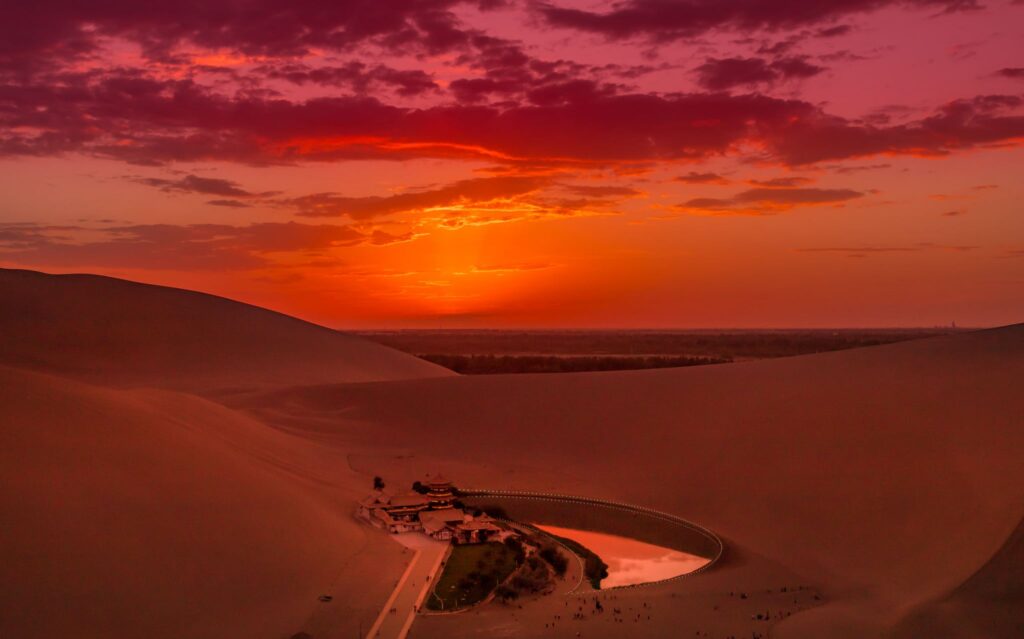
An Essential Guide to Visiting Dunhuang Mogao Caves
Nestled in the arid expanse of the Gobi Desert, the Dunhuang Mogao Caves, also known as the Caves of the Thousand Buddhas, stand as a monumental testament to China’s rich cultural and religious history. This UNESCO World Heritage Site, dating back to the 4th century, is a breathtaking sanctuary of art, where intricate wall frescoes and over 3,000 sculptures narrate the evolution of Buddhist thought and artistry over a millennium.
As you approach this remarkable site, the stark desert landscape transforms into an oasis of color and creativity. The caves, carved into the cliffs, are not merely an archaeological wonder but a vibrant canvas showcasing the confluence of diverse cultures that once thrived along the ancient Silk Road. Each cave tells a story, inviting you to step back in time and immerse yourself in the spiritual and artistic endeavors of the generations who sought solace and inspiration within these walls.
Visiting the Mogao Caves is more than just admiring ancient art; it’s about experiencing the profound silence that envelops these sacred spaces, allowing for a moment of reflection amidst the hustle of modern life. Travelers from around the globe come to witness this unique heritage, making it a must-visit destination for anyone seeking to connect with the spiritual essence of Buddhism and the history of the Silk Road. Whether you’re an art lover, history buff, or a curious traveler, the Mogao Caves promise an unforgettable journey into the heart of China’s cultural legacy.
In This Guide
- An Essential Guide to Visiting Dunhuang Mogao Caves
- The Rich History and Legends of Dunhuang Mogao Caves
- Main Highlights: What You Absolutely Can’t Miss
- Planning Your Visit: A Practical Guide
- Tickets: Prices, Booking, and Tips
- How to Get There: A Complete Transportation Guide
- Local Cuisine and Accommodation Nearby
- Frequently Asked Questions
- Final Thoughts on Your Trip
The Rich History and Legends of Dunhuang Mogao Caves
Nestled in the arid expanses of the Gobi Desert, the Dunhuang Mogao Caves, also known as the Caves of the Thousand Buddhas, stand as a testament to the rich tapestry of cultural exchange and artistic achievement along the ancient Silk Road. Dating back to the 4th century, this remarkable site comprises 492 caves filled with exquisite murals and more than 3,000 sculptures, showcasing the evolution of Buddhist art over a millennium.
The origins of the Mogao Caves can be traced to a group of monks seeking solitude and enlightenment. As they settled into the cliffs near the ancient city of Dunhuang, they began to carve out these caves, which would eventually serve as a significant center for Buddhist study and practice. The location was strategically chosen; it was a vital stop for traders traveling the Silk Road, allowing the caves to flourish as a nexus of commerce, culture, and religion.
Over the centuries, the Mogao Caves attracted countless pilgrims, artists, and scholars from diverse regions, each leaving their mark on the site. The caves were adorned with murals depicting scenes from the life of Buddha, bodhisattvas, and a myriad of Buddhist deities, reflecting the influences of various artistic styles from Central Asia, India, and beyond. This fusion resulted in a unique artistic language, rich in color and symbolism.
One of the most captivating stories associated with the Mogao Caves is that of the “Library Cave,” discovered in 1900 by the Taoist monk Wang Yuanlu. Hidden behind a sealed wall, this cave contained an extraordinary trove of ancient manuscripts, scriptures, and artworks, providing invaluable insights into the cultural and religious landscape of the time. The discovery sparked global interest and led to the eventual dispersal of many of these treasures across museums and private collections worldwide.
Today, the Mogao Caves are recognized as a UNESCO World Heritage Site, drawing visitors from around the globe who come to marvel at the intricate artistry and delve into the profound history encapsulated within these hallowed walls. The caves not only represent the spiritual and artistic endeavors of ancient Buddhists but also symbolize the enduring legacy of the Silk Road as a conduit of cultural exchange.
As you wander through the cool, dimly lit chambers of the Mogao Caves, you are enveloped in stories of devotion, artistry, and the relentless passage of time. Each mural and statue whispers tales of the countless souls who sought enlightenment and understanding within these sacred spaces, making the Mogao Caves a must-visit for any traveler eager to connect with the profound history of human civilization.
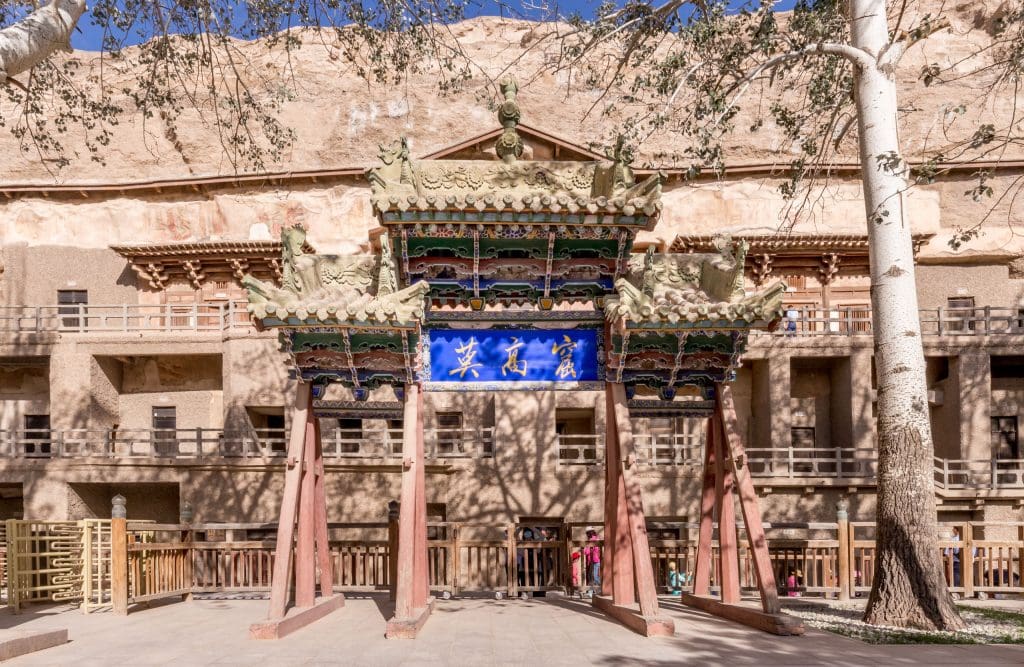
Dunhuang Mogao Caves.
Main Highlights: What You Absolutely Can’t Miss
Visiting the Dunhuang Mogao Caves is a journey through a tapestry of art, history, and spirituality. Nestled in the Gobi Desert, this UNESCO World Heritage site promises an unforgettable experience for any traveler. Here’s what you absolutely cannot miss during your visit:
1. The Magnificent Frescoes
As you step into the caves, your eyes will be drawn to the stunning wall frescoes that adorn the cave interiors. Dating back to the 4th to 14th centuries, these vibrant paintings depict scenes from Buddhist lore, significant historical events, and daily life, showcasing the artistic genius of the era. Be sure to look for the intricate details and vivid colors that have endured the test of time.
2. Iconic Statues
The Mogao Caves house over 3,000 sculptures, with the most notable being the colossal Maitreya Buddha statue, which stands at an impressive 34 meters tall in Cave 130. This awe-inspiring figure, along with many others, represents the evolution of Buddhist art and reflects the cultural exchanges along the ancient Silk Road.
3. The Digital Exhibition Center
Before heading to the caves, make a stop at the Dunhuang Mogao Caves Digital Exhibition Center. Here, you can enjoy immersive multimedia presentations that provide a context for the art and architecture you’ll encounter in the caves. The 360-degree film is particularly impressive and sets the stage for the wonders that await you.
4. Guided Tours of Select Caves
Due to preservation efforts, only a limited number of caves can be visited each day. Opt for a guided tour to make the most of your experience. English-speaking guides will take you through the most significant caves, offering insights into the history, artistry, and cultural significance of the artworks. Make sure to ask questions and engage with your guide for a deeper understanding.
5. Cave Exploration
While the guided tour will cover key highlights, don’t miss the opportunity to explore some of the other open caves on your own. Each cave has its unique charm and artistic style, and wandering through them allows you to appreciate the vastness of this ancient site. Bring a notebook to jot down the cave numbers you visit!
6. The Natural Beauty of the Surroundings
After immersing yourself in the artistic wonders of the caves, take a moment to appreciate the stark beauty of the Gobi Desert. The surrounding landscape offers spectacular views and a serene atmosphere that enhances the spiritual experience of the caves.
7. Practical Tips
- Timing: Plan for a visit of around 2-3 hours, but if you can, extend your stay to soak in the experience.
- Tickets: Purchase your tickets in advance, preferably through official channels. Note that there might be restrictions on group sizes for guided tours.
- Amenities: Bring water and snacks, as food is not available on-site, and you might want to take breaks in the shade.
8. Nearby Attractions
Don’t miss the opportunity to explore other nearby attractions after your visit to the caves. The Crescent Moon Spring and the Singing Sand Dunes are perfect complements to your Dunhuang experience, offering stunning landscapes and more insights into this historical region.
With its breathtaking artistry, rich history, and unique cultural significance, the Mogao Caves are a must-visit for anyone traveling in China. Make sure to take your time and absorb the beauty that surrounds you. Happy travels!

Dunhuang Mogao Caves.
Planning Your Visit: A Practical Guide
Visiting the Dunhuang Mogao Caves is a journey through time, immersing you in a world of stunning art, rich history, and serene landscapes. To ensure you have a rewarding experience at this UNESCO World Heritage site, here’s a practical guide to help you plan your visit.
Getting There
Dunhuang is located in Gansu Province, China, and is accessible by various means of transport:
-
By Air: Dunhuang has its own airport, the Dunhuang Mogao Airport (DNH), which offers flights from major cities such as Beijing and Xi’an. From the airport, you can take a taxi or pre-arranged shuttle to your accommodation or the Mogao Caves.
-
By Train: The Dunhuang Railway Station connects the city with several other cities along the Silk Road. From the station, taxis are readily available to take you to the caves.
-
By Bus: Long-distance buses operate from nearby cities and provinces. This is a more economical option, though it may take longer.
Best Time to Visit
The ideal time to visit Dunhuang is during the spring (April to June) and autumn (September to October) when the weather is mild and pleasant. Summer months can be hot, with temperatures soaring above 30°C (86°F), while winter can be quite cold.
Opening Hours
The Mogao Caves are open daily from 9:00 AM to 5:00 PM, providing ample time to explore during daylight hours. Last entry is usually around 4:00 PM, so plan your visit accordingly.
Ticketing Information
-
Ticket Purchase: It is highly recommended to purchase your tickets in advance, especially during peak tourist seasons. Tickets can be obtained through the official Trip.com website or at the visitor center.
-
Pricing: The admission fee is approximately 250 yuan (around $35 USD) per person. This includes access to a series of caves and a guided tour, which is essential for understanding the art and history of the site.
Arrival at the Site
-
Visitor Center: Begin your visit at the Dunhuang Mogao Caves Digital Exhibition Center. Here you can enjoy informative films about the caves and their historical significance. The center also provides audio guides in various languages, including English and Japanese, for a more immersive experience.
-
Guided Tours: After the exhibition, you will be guided to the caves. It’s important to inform the staff that you are a foreigner to receive appropriate guidance. Currently, only eight caves are included in the guided tours, allowing for an in-depth exploration of these significant artworks.
Exploring the Caves
-
Duration: Plan to spend 2-3 hours at the Mogao Caves to fully appreciate the art and history.
-
What to Expect: Each cave showcases exquisite wall frescoes and sculptures dating back to the 4th to 14th centuries. Take your time to absorb the intricate details and listen to the guide’s commentary.
-
Additional Caves: After the guided portion, you may have the opportunity to peek into other caves that are open to the public. However, be sure to keep track of the cave numbers you’ve visited.
Tips for Your Visit
-
Stay Hydrated: Bring plenty of water and snacks, as there are no food vendors within the cave area. You can eat in designated areas outside the caves.
-
Comfortable Footwear: Wear comfortable walking shoes, as you will be walking and standing for extended periods.
-
Photography Restrictions: Be aware that photography is generally not allowed inside the caves to protect the artwork. Enjoy the experience without the distraction of a camera.
-
Plan Your Day: Consider combining your visit to the Mogao Caves with other attractions in Dunhuang, such as the Singing Sand Dunes and Crescent Moon Spring, which can be explored either before or after your cave visit.
Nearby Attractions
Dunhuang offers a wealth of attractions beyond the Mogao Caves. Don’t miss the opportunity to explore:
-
Crescent Moon Spring: A picturesque oasis located near the Singing Sand Dunes, perfect for a serene afternoon.
-
Singing Sand Dunes: Experience the unique phenomenon of the dunes singing as you walk or slide down their slopes.
-
Dunhuang Grotto Art Protection, Examination and Exhibition Center: Further your understanding of the region’s rich artistic heritage.
Final Thoughts
Visiting the Dunhuang Mogao Caves is more than just sightseeing; it’s an exploration of cultural history and artistic endeavor. With careful planning and an appreciation for the journey, your visit will undoubtedly be a highlight of your travels through China. Enjoy the beauty and tranquility of this remarkable site as you step into the annals of history!
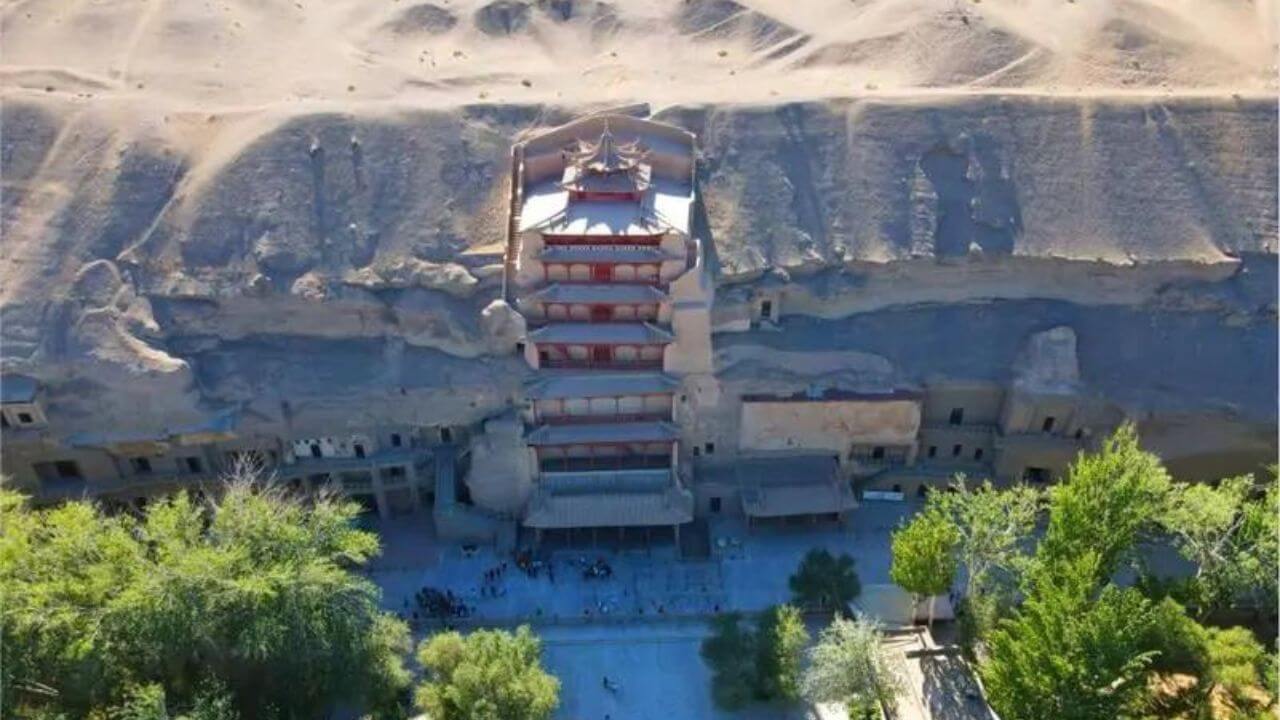
Dunhuang Mogao Caves.
Tickets: Prices, Booking, and Tips
Visiting the iconic Dunhuang Mogao Caves offers an unparalleled glance into the rich tapestry of Buddhist art and history. To make the most of your experience, understanding the ticketing process, pricing structure, and some practical tips can enhance your journey through this UNESCO World Heritage site.
Ticket Prices
Admission to the Mogao Caves typically costs around 250 yuan (approximately $35 USD) per person. This fee grants access to the visitor center, where you can enjoy a high-quality audiovisual presentation about the caves. Keep in mind that prices may vary slightly depending on the season or special exhibitions, so it’s wise to check the official website or reputable travel platforms for the latest updates.
Booking Your Tickets
For international travelers, purchasing tickets in advance is highly recommended, particularly during peak tourist seasons. While you can buy tickets at the site, securing them online through platforms like Trip.com ensures a smoother experience. This is especially important as some reservations may not be available at the site for foreign visitors due to system restrictions.
Guided Tours
Upon arrival, you’ll first visit the Dunhuang Mogao Caves Digital Exhibition Center, where you can watch two short films introducing the caves. If you inform the staff that you are a foreigner, they can provide you with headphones for an audio guide in English or other languages, enhancing your understanding of the content.
The caves are not open for unrestricted exploration; instead, guides lead you through selected caves. Currently, only a limited number (around eight) can be fully explained by a guide. To make the most of your visit, consider joining a small group tour, which often allows for a more intimate experience compared to the larger Chinese groups.
Tips for Your Visit
-
Plan Your Day: Allocate 2-3 hours for the entire visit, including time spent in the exhibition center and the caves.
-
Stay Hydrated and Snack Ready: While food and drinks are not sold within the cave area, you are allowed to bring your own. Pack water and snacks to stay energized during your visit.
-
Timing is Key: Arrive early in the day to avoid the crowds. This will give you a better chance of enjoying the caves with fewer visitors.
-
Record Your Experience: Since you can only view a select number of caves, jotting down their numbers can help you recall your visit later.
-
Check for Special Events: Occasionally, there are performances or special exhibitions related to the caves that can provide additional context to your visit.
By following these guidelines, you can enjoy a seamless and enriching experience at the Dunhuang Mogao Caves, immersing yourself in the artistry and spirituality that this remarkable site has to offer.
How to Get There: A Complete Transportation Guide
To explore the majestic Dunhuang Mogao Caves, a UNESCO World Heritage site renowned for its exquisite art and historical significance, getting there is a straightforward process. This guide will walk you through the various transportation options available to make your journey smooth and enjoyable.
Arriving in Dunhuang
By Air:
The most convenient way to reach Dunhuang is via the Dunhuang Airport (DNH), which has regular flights from major Chinese cities such as Beijing, Shanghai, and Xi’an. Airlines like China Eastern, Air China, and Hainan Airlines operate flights to and from Dunhuang. The airport is located approximately 15 kilometers (9 miles) from the city center, making it easy to reach your destination quickly.
Transportation from the Airport:
Upon arriving at the airport, you can opt for several modes of transportation to the city and the Mogao Caves:
– Taxi: Easily available at the airport, a taxi ride to the city center will take around 20-30 minutes and will cost approximately 40-60 RMB.
– Airport Shuttle: Look for the airport shuttle bus service, which connects the airport to various locations in Dunhuang. This is a budget-friendly option, typically costing around 20 RMB per person.
By Train:
If you prefer a more scenic route, consider taking a train to Dunhuang. The Dunhuang Railway Station is well connected to various cities across China, including Lanzhou, Urumqi, and Zhangye. High-speed trains have made travel more efficient, so check the schedule in advance.
Transportation from the Train Station:
– Taxi: Taxis are readily available outside the train station. A ride to the city center takes about 10-15 minutes and costs around 20-30 RMB.
– Local Buses: Several local buses also run from the train station to different parts of the city, providing a cost-effective alternative.
Getting to the Mogao Caves
Once you are in Dunhuang, reaching the Mogao Caves is quite straightforward:
By Bus:
– Public Bus: Take Bus 3 from the city center to the Mogao Caves. The fare is quite affordable, typically around 5 RMB. Buses run every 15-20 minutes, making it a convenient option.
– Tourist Shuttle Bus: If you’re short on time or prefer a direct service, consider using the tourist shuttle bus from the Dunhuang Digital Exhibition Center, which transports visitors directly to the caves.
By Taxi:
For a more direct and personalized approach, taxis are readily available throughout the city. A taxi ride from the city center to the Mogao Caves will take about 15-20 minutes and cost approximately 30-50 RMB.
Guided Tours:
Many local tour operators offer packages that include transportation to the Mogao Caves along with guided tours of the site. These tours often include tickets, a knowledgeable guide, and sometimes additional highlights like the Singing Sand Dunes and Crescent Moon Spring. This can be an excellent way to enrich your experience.
Tips for Your Journey
- Book in Advance: If possible, book your tickets for the Mogao Caves in advance, especially during peak tourist seasons, as entry is often limited, and guided tours can fill up quickly.
- Audio Guides: Consider renting an audio guide at the caves for a more in-depth understanding of the art and history.
- Stay Hydrated: The desert climate can be quite dry, so ensure you have water with you, especially if you plan to explore extensively.
With a well-planned itinerary, your visit to the Dunhuang Mogao Caves can be both memorable and seamless. Whether you choose to fly, take a train, or join a guided tour, you’re bound to be captivated by the breathtaking artistry and historical significance of this remarkable site.
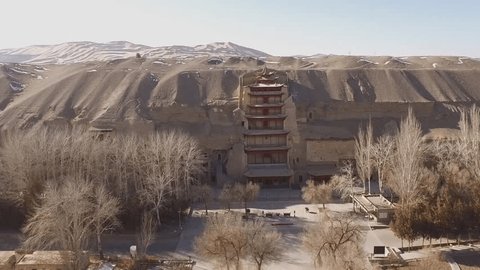
Dunhuang Mogao Caves.
Local Cuisine and Accommodation Nearby
When visiting the magnificent Dunhuang Mogao Caves, indulging in local cuisine and finding comfortable accommodation nearby can significantly enhance your travel experience. Here’s a curated selection of both to help you savor the flavors of the region while enjoying a restful stay.
Culinary Delights
1. Shazhou Night Market
– A vibrant hub for food lovers, the Shazhou Night Market is a must-visit. Here, you can sample an array of local delicacies, including mutton skewers, hand-pulled noodles, and Dunhuang-style pastries. The bustling atmosphere provides a perfect backdrop for trying various street foods and mingling with locals.
2. The Silk Road Restaurant
– Located conveniently near the Mogao Caves, this restaurant offers a mix of traditional Chinese flavors and Silk Road-inspired dishes. Don’t miss their Lanzhou beef noodles and spicy lamb hot pot, which are both crowd favorites. The cozy ambiance and friendly service make it a great spot to relax after a day of exploration.
3. Dunhuang Specialties Restaurant
– For a more refined dining experience, head to this establishment where you can taste authentic Dunhuang dishes. The menu features stuffed dumplings and local fish dishes, prepared with fresh ingredients. The restaurant prides itself on showcasing the culinary heritage of the region.
4. Local Tea Houses
– After your visit to the caves, unwind at one of Dunhuang’s charming tea houses. These spots offer a selection of local teas and snacks, perfect for a light afternoon break. Try the goji berry tea, known for its health benefits, while enjoying the serene atmosphere.
Accommodation Options
1. Dunhuang Hotel
– Just a short drive from the Mogao Caves, Dunhuang Hotel combines comfort with convenience. The hotel features spacious rooms, a restaurant serving local cuisine, and a lovely garden area to unwind. It’s an ideal base for those looking to explore the area.
2. Dunhuang International Hotel
– This hotel offers modern amenities and exceptional service, making it a popular choice for international travelers. The on-site restaurant serves a variety of local dishes, and the rooftop bar provides stunning views of the surrounding desert landscape.
3. Silk Road Dunhuang Hotel
– A blend of traditional architecture and contemporary comfort, this hotel is located near the city center. It offers well-appointed rooms and a restaurant that specializes in both local and international cuisine. The staff is known for their hospitality, ensuring a pleasant stay.
4. Guesthouses and Hostels
– For budget travelers, several guesthouses and hostels are available near the Mogao Caves. These offer a more intimate and local experience. The atmosphere is friendly, and you can often find fellow travelers to share stories and tips.
Conclusion
With these dining and lodging options, your visit to the Dunhuang Mogao Caves will be both culturally enriching and comfortable. Enjoy the local flavors and relax in welcoming accommodations as you immerse yourself in the beauty of this historical site.
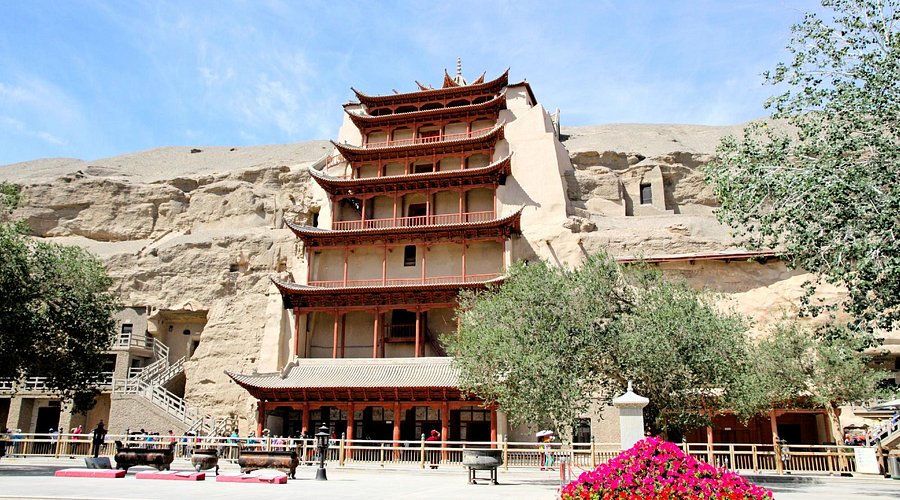
Dunhuang Mogao Caves.
Frequently Asked Questions
Frequently Asked Questions about the Dunhuang Mogao Caves
1. What are the opening hours for the Mogao Caves?
The Mogao Caves are open daily from 9:00 AM to 5:00 PM. It’s advisable to arrive early to fully enjoy the complex and avoid crowds.
2. How long should I plan to spend at the Mogao Caves?
Most visitors spend about 2 to 3 hours exploring the caves. This includes time spent at the visitor center, watching the introductory films, and touring the caves themselves.
3. Is there an admission fee to enter the Mogao Caves?
Yes, the admission fee is approximately 250 yuan. This fee includes access to the caves and the digital exhibition center, which is highly recommended for a comprehensive understanding of the site’s history and significance.
4. Are guided tours available for visitors?
Absolutely! Guided tours are available, and it’s a great way to enrich your experience. English-speaking guides can be arranged, and it’s recommended to inform the staff upfront if you require assistance in a specific language.
5. Can I take photos inside the caves?
Photography is strictly prohibited inside the caves to protect the delicate murals and sculptures. However, you can take photos in the surrounding areas and at the visitor center.
6. What should I wear and bring during my visit?
Dress comfortably and wear appropriate footwear, as you’ll be walking quite a bit. Bringing a bottle of water and snacks is also a good idea since food and drink are not sold within the cave area.
7. How can I get to the Mogao Caves?
The caves are located about 25 kilometers from Dunhuang city center. You can take a taxi, join a guided tour, or use local transportation options such as buses that operate between the city and the caves.
8. Are there facilities available for international travelers?
Yes, the visitor center offers various amenities, including information desks, restrooms, and digital exhibits with translations in multiple languages. Ensure to check in for any special needs or requests upon arrival.
Final Thoughts on Your Trip
As you wrap up your journey to the Dunhuang Mogao Caves, take a moment to reflect on the profound beauty and historical significance of this UNESCO World Heritage site. Nestled in the vast Gobi Desert, the caves stand as a testament to centuries of artistic expression and spiritual devotion. Each fresco and sculpture tells a story, inviting you to connect with the ancient cultures that once flourished along the Silk Road.
Whether it was wandering through the intricate chambers, soaking in the mesmerizing artistry, or learning from your knowledgeable guide, every experience here contributes to a deeper understanding of human creativity and resilience. The Mogao Caves are not just a destination; they are a journey through time, an opportunity to feel the pulse of history in every brushstroke and chiseled figure.
As you leave this remarkable place, carry with you the inspiration it has sparked. The echoes of the past blend seamlessly with the present, reminding us that the pursuit of beauty and knowledge transcends time and borders. Whether you share your stories with fellow travelers or keep them close to your heart, the Mogao Caves will forever remain a cherished chapter in your travel narrative. Safe travels, and may your adventures continue to inspire and enlighten!